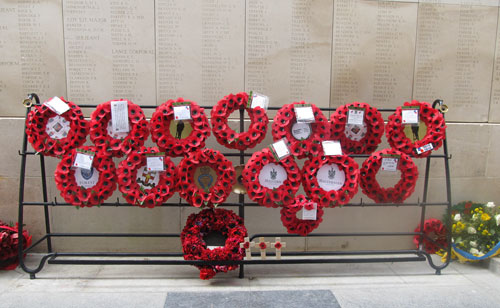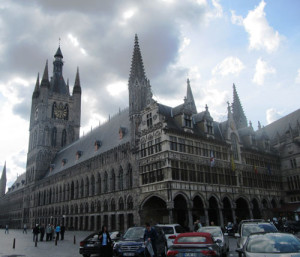By SUSAN MARQUEZ
“IN FLANDER’S FIELDS”
By Lieutenant Colonel John McCrae
(Composed at the battlefront on May 3, 1915 during the second battle of Ypres, Belgium.)
In Flanders Fields the poppies blow,
Between the crosses, row on row,
That mark our place: and in the sky,
The larks, still bravely singing, fly,
Scarce heard amid the guns below.
We are the dead: Short days ago,
We lived, felt dawn, saw sunset glow,
Loved and were loved: and now we lie
In Flanders fields!
Take up our quarrel with the foe
To you, from failing hands, we throw
The torch: be yours to hold it high
If ye break faith with us who die,
We shall not sleep, though poppies grow,
In Flanders fields.
Many folks recall a time when bright red poppies were worn on the lapels of men and women alike on Memorial Day and other patriotic holidays. The poppies were sold by members of the local Veterans of Foreign Wars of the United States or The American Legion, who both used the funds to help support disabled and needy veterans and their children.
Kathy Sage Moon of Jackson remembers her father and grandfather being members of The American Legion when she was growing up in West Point, Mississippi, and her mother was a member of the Ladies Auxiliary. “I can remember going to the American Legion dinners and social functions they had. There were lots of members, older ones from WWI, and then a lot of folks my parents’ age, from WWII. They had, and still have, their own building. Folks could rent it out for other functions.” Moon says she vividly remembers the poppy sales. “I can’t remember if there was a set price or donation. I loved those paper poppies! I didn’t understand the sacrifice the poppies represented until I read In Flanders Field, but I did understand that it was a patriotic thing to do—buy a poppy.”
The poppy was first chosen as The American Legion’s memorial flower at the 1921 National Convention and was worn in memory of the men who lost their lives in World War I. While the war was devastating, one bright color on fields and hills of the war-torn areas was the red poppy. The hearty poppies grew along the edges of the trenches and bloomed on the graves of men buried in sacred plots of French soil, known as Flanders Field. It was the remembrance of the bright red flowers, and the men who shed blood in that place, that American soldiers returned home with the poppies, which became a symbol of the dead and a way to honor the high ideas for which the brave young men gave their lives.
Barry Plunkett of Jackson recently visited the WWI museum in Flanders, Belgium. “The red poppy is their official icon for the museum and the year-long memorial.” Plunkett says he was struck by the memorial with its red poppy wreaths. “They were in bloom everywhere.” The poppies grew in popularity across Europe, including a poppy remembrance memorial at the Tower of London.
According to the VFW website (www.vfw.org), the organization conducted its first poppy distribution before Memorial Day in 1922, becoming the first veterans’ organization to organize a nationwide distribution. The poppy soon was adopted as the official memorial flower of the Veterans of Foreign Wars of the United States.
In 1923, the VFW decided that funds from the VFW “Buddy”® Poppies assembled by disabled and needy veterans would go to help provide them with financial assistance. The disabled veterans began assembling the poppies at a factory in Pittsburgh and the name “Buddy Poppy” was adopted at that time. In February 1924, the VFW registered the name “Buddy Poppy” with the U.S. Patent Office. A certificate was issued on May 20, 1924, granting the VFW all trademark rights in the name of “Buddy” under the classification of artificial flowers. The VFW has made that trademark a guarantee that all poppies bearing that name and the VFW label are genuine products of the work of disabled and needy veterans. No other organization, firm, or individual can legally use the name Buddy Poppy.
Today, VFW Buddy Poppies are still assembled by disabled and needy veterans in VA Hospitals.
The VFW Buddy Poppy program provides compensation to the veterans who assemble the poppies, as well as providing financial assistance in maintaining state and national veterans’ rehabilitation and service programs and partially supports the VFW National Home for Children.
Patsy Mooney Patten of Jackson remembers the poppies made of red crepe paper. “The veterans carried them in a white box around their necks. There was a poppy day and The American Legion and VFW were all over town. We paid a nickel in the 1950s, but everyone wore one.”
Different folks remember the poppies being sold at different times of the year. Kathy Rhodes, a Mississippi native living in Franklin, Tennessee, says she remembers Buddy Poppy Day, which was typically centered around Memorial Day, held the last day of May.
Paula Brian, a resident of Madison, remembers wearing poppies on Remembrance Day each November 11 in her native Canada. “Wreaths are also placed in public places such as businesses and such,” says Brian.
Michelle Agustin, a Taylorsville native living in Canada, says that people start wearing them the beginning of November. “There are lots of Remembrance Day ceremonies at 11 a.m. on November 11. The tradition is to then leave your poppy at the cenotaph (a structure or monument built to honor those who died in war).”
Moon recalls that in later years, her parents were some of the few still active in The American Legion in West Point. “So many had died, or were no longer able to come. I lost my dad early, at age 68, but my mother continued to serve in the Ladies Auxiliary. Her neighbor and fellow Auxiliary member later became the county’s Veteran’s Affairs Officer. That’s when my mother’s participation, and that of her friends, really got cranked up. Mrs. AnnaBelle didn’t take ‘no’ for an answer! The chapters across the state became very involved in helping support the regional state veteran’s homes and Mrs. AnnaBelle made sure Clay County’s contributions were the best they could be. Poppy sales became even more important.”
Lisa McGovern of Madison distinctly remembers shopping with her mother, around 1972. “We were on Northside Drive in Jackson, next to the Sunflower. A veteran in an old uniform was selling red poppy lapel pins. My mother gave him a dollar or two and we each got a poppy. I recall walking through the dime store wearing them. I do remember it was Veteran’s Day.”
The poppies are still made and distributed by disabled veterans with the VFW and The American Legion. While not as common as they were in times past, the poppies are still a cheerful, yet solemn reminder of the sacrifices of those who fought overseas to defend our freedom.
Susan Marquez, a professional writer and “empty nester,” Susan enjoys life in Madison with her husband, Larry. They enjoy watching their son, Joe, play football for Millsaps College and they marvel at the miracle of daughter, Nicole,who has survived the unimaginable and is now a sought-after motivational speaker. Susan is currently writing a book about Nicole. (To learn more, visit www.youcantstopthisdancer.com.)



